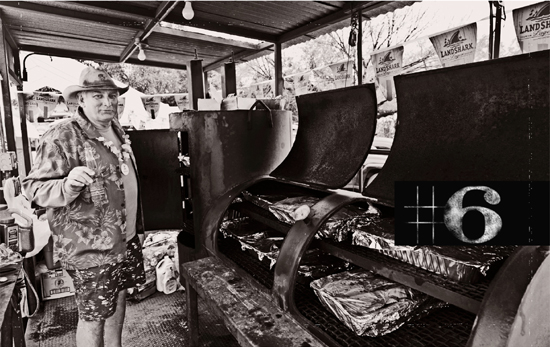
Tailgaters are known for their creative grilling techniques and bold fashion statements
On a sunny Sunday afternoon in November, in the parking lot of Reliant Stadium, a few hours before the Houston Texans game, I came upon a city of grills. • I had heard that there was some serious tailgating before the Houston Texans games, so I thought I’d look around the parking lots and get an overview of what people were grilling. But I had no idea what I was getting into. I wrote down recipes until my fingers hurt. And I never even made it past the main gate area.
In front of the main gate, I climbed on top of the school bus with an observation deck to get a look around. From that vantage point, I saw thousands of smoky fires in all directions. There were more plumes of smoke coming from remote parking lots that were more than a mile away.
Houston Texans officials estimate thirty thousand people tailgate before the average home game. In a survey, 52 percent of Texans fans said they ate in the parking lot before the game. When the Texans play Monday Night Football at home, the crowd swells and the cooking gets even more serious. That’s when the turduckens and the whole hogs show up.
Why do they do it? What’s the point of tailgating? To create fan camaraderie and support the football team, rabid tailgaters will tell you. But these motives hardly explain what tailgating in Texas has become.
It’s a party and a pep rally, for sure. But tailgating has become a sport unto itself. These gatherings have turned into the purest form of culinary competitions; this is where the best grillers in Texas go to show off in public. In this small “city” of thirty thousand, there are all kinds of cooks. But nearly all of them are putting on a show.
A white-haired gentleman named Sal Ramirez was sitting behind his vehicle grilling on a tiny charcoal grill. He was only cooking a couple of boneless, skinless chicken breasts for himself and a lady friend. But his grapefruit marinade was unique (see the recipe on here). And he was quick to point out that the red grapefruits came from his own backyard.
This tailgater has his jalapeño links custom-made at the Chappel Hill Meat Market by legendary sausage-maker Mike Kopycinski
Nearby, Jacob Trevino flipped his special-recipe stuffed hamburgers. The half-pound patties were made of ground chuck mixed with chopped black olives, chipotle peppers, several kinds of cheese, and Lipton onion soup mix, he told me. Inside each patty, he had created a pocket and stuffed it with cheddar and chiles. (See my version.) Trevino hunted me down a few hours later so I could try one of his Tex-Mex stuffed burgers. (It was terrific.) Another tailgater, named Gabe Gonzales, handed me a roasted jalapeño stuffed with cream cheese. Most tailgaters bring a little extra food to give away. Some bring a lot of extra food to give away.
Wild game is especially popular at football games. I have seen elk, wild boar, and venison served at tailgate parties. Wild game is great for impressing fellow tailgaters, since you can’t buy it at the grocery store or order it in restaurants. Besides, I suspect that in many households, Mom is eager for Dad to get that deer meat out of the freezer. (That’s the way it was when I was growing up, anyway.)
In the south parking lot in front of the stadium’s main gate, the Raging Bull Tailgaters, winners of the Tailgater of the Year award (which is paid in grocery store coupons) a few years ago, served free food to hundreds of people they had never met before. Each week the team of eight spends two thousand dollars on food. Typically the menu includes half a dozen briskets, half a dozen pork loins, 10 racks of ribs, 30 pounds of chicken wings, 100 pounds of sausage, 40 pounds of shrimp, 20 pounds of fish steaks, and 100 pounds of smoked boudin. There are seldom any leftovers.
Saint Arnold’s, the local microbrewery, shows up every week with lots of beer. Stadium rules prohibit charging any money, so everything is free.
Years ago, there was a similar spirit at Texas barbecue cook-offs. But the rigid rules and rising costs ruined all that. Today, barbecue cook-off teams at the Houston Livestock Show and Rodeo Barbecue Cook-off (which is also held in the same parking lot) are required to carry million-dollar liability insurance policies. Successful teams seek corporate sponsorships to defray the expenses. In exchange, the team serves as a caterer for the corporation’s functions. You have to have a corporate wristband to get into the party and the barbecuing that was once a joy turns into a job.
Tailgaters grill whatever they want—just for the fun of it. Some put on a big show and some cook quietly with class.
FeedYard Saloon, voted Tailgater of the Year a few years ago, serves brisket and beans to the public from a modern chuck wagon. Family Feud comes in a school bus painted half maroon and half burnt orange—the colors of archrivals Texas A&M and the University of Texas. They serve gourmet tailgating fare including chorizo-stuffed quail and grilled chicken in cilantro cream sauce. The owners of a Mexican-American meat company gave me a taste of a wild boar cooked in a caja china—a Cuban pig-roasting box with a mesquite grill on top. (See La Caja China.)
Next to grills on trailers the size of my car, I ate medallions of venison backstrap served on hot biscuits with gravy, cheese-stuffed jalapeños wrapped in venison sausage, and grilled shrimp and pineapple kebabs. But I also learned a lot from people sitting in lawn chairs beside tiny propane grills where they cooked grilled asparagus, grilled artichokes, and countless delicacies wrapped in bacon. Bacon is the butcher’s string, cooking oil, and garnish, all in one.
Tailgaters are incredibly ingenious. They can bake or steam on the grill with a little aluminum foil. Margarita mix straight out of the bottle becomes an easy marinade for pork, and Bloody Mary mix doubles as a great shrimp cocktail sauce (see the recipe here).
The secret to tailgate grilling is lots of advance preparation. Tailgaters tinker with the seasonings and precook things at home in the kitchen so that when they get to the stadium, there’s nothing left to do but throw it on the grill. It’s a great technique for backyard grillers, too. Take it from the tailgaters: when you’re entertaining in your backyard, do the prep work a day in advance. Then on the day of the party, relax and enjoy.
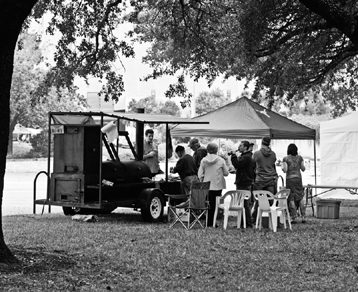
TAILGATING IN Texas is a tribal bonding ritual

Oktoberfest celebration at the football stadium
HOUSTON TEXANS
The Houston Oilers prohibited tailgating at the Astrodome. But when the Texans brought NFL football back to Houston, the new owners decided to promote tailgating as a way to build fan loyalty. The team started the Tailgater of the Game and Tailgater of the Year, competitions that are sponsored by Texas supermarket chain H-E-B. The winner receives a few gift certificates. (Which is next to nothing compared with the huge cash prizes at top barbecue cook-offs.)
Joe Cahn, the self-proclaimed “Commissioner of Tailgating” travels around the country checking out the action. Cahn proclaimed Houston’s Reliant Stadium tops in the NFL tailgating scene because of the enormous expanse of the parking lots and the quality of the cooking.
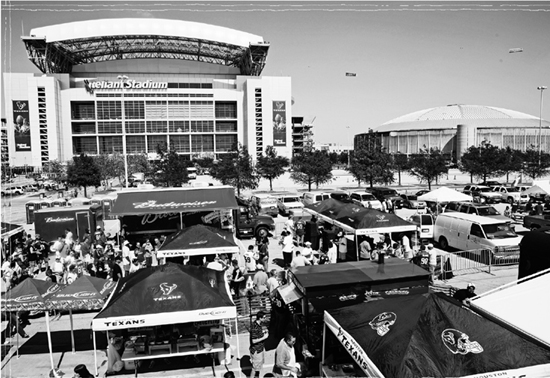
Tailgater grilling at a University of Texas Longhorns game in Austin
24 chicken wings
2 tablespoons Red Rub
4 tablespoons (½ stick) butter
1 cup Ancho–Root Beer BBQ sauce
1 teaspoon habanero pepper sauce, or to taste
6 celery stalks, cleaned and chopped into short pieces
GRILLING SEASON
In Texas, the grilling seasons are reversed. When most of the country is putting away the Weber for the winter, Texans are tailgating at football games and grilling wild game. The backyard barbecue season is a lot longer in Texas and in most of the South too. Late fall, winter, and early spring are generally the nicest times of the year to eat outside. When southerners grill in the summer, it’s often to avoid heating up the house.
Four 8-inch wooden skewers, soaked in water for 15 minutes
1 pound jumbo shrimp (16 shrimp)
½ cup grapefruit juice
¼ cup jalapeño jelly
2 cloves garlic, minced
1 tablespoon vegetable oil
2 tablespoons soy sauce
Cooking spray
2 ripe avocados, sliced
1 cup chopped red onion
Juice of 1 lime
Tabasco sauce, to taste
½ cup chopped fresh cilantro leaves, for garnish
LA CAJA CHINA: THE CUBAN PIG ROASTER
The portable pig-roasting box, or caja china, probably originated in Cuba. Beachside food vendors use them to prepare picnic sandwiches in Puerto Rico. The box started turning up on the East Coast a few years ago when a company in Miami started marketing them under the name “La Caja China.” The medium-size box sold at the company’s website for around three hundred dollars and cooked a seventy-pound whole pig in four hours. The pig comes out with a nice crispy skin, too.
While checking out the tailgating action at Reliant Stadium during football season, I stopped to admire what looked like a charcoal grill loaded with fajita meat and tortillas. But Mariano Moreno, the grill chef, threw me a curve ball. The grill had a pair of what looked like wheelbarrow handles sticking out of each side. Mariano summoned a friend over and they used these handles to lift up the entire firebox and grill assembly to show me what was below.
In an insulated box underneath the coals, there was a slow-cooking chamber that was big enough to accommodate a whole pig. As it happened, Moreno and company had already cooked and consumed a whole wild hog earlier in the day. Now they were cooking whole sections of beef short ribs in their amazing “Chinese box.”
Moreno and company told me they bought their caja china in Monterrey, where the device is often used to slow-roast cabrito.
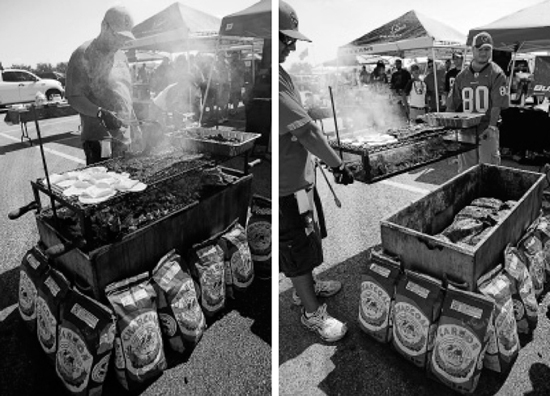
This Caja china has a large removable grill with four stout handles. In the cooking chamber below, several pork roasts were being slow-roasted.
Four 7-ounce boneless, skinless chicken breasts
1 clove garlic, minced
2 tablespoons ground Mexican oregano
Juice of 2 Texas red grapefruits
1 tablespoon olive oil
Salt and pepper
6 flour tortillas
THE KING OF TEX-MEX: MATT MARTINEZ
Matt Martinez Jr., the King of Tex-Mex, loved to tell stories about his days of playing hooky from school and going fishing and hunting in the wilderness that was once South Austin.
“I spent so much time hunting and fishing, I flunked third grade,” he used to say. “The best fishing hole in the city used to be right where Barton Creek emptied into Town Lake,” he remembered. “I used to come home with twenty or thirty perch from that spot. You can’t even eat the fish from Town Lake anymore.”
Matt was a fourth-generation Tex-Mex cook. His grandfather Delphino sold tamales and pecan pralines from a cart he pushed on Congress Avenue before opening El Original, one of the first Tex-Mex restaurants in Austin, in 1925. Matt Senior founded Matt’s El Rancho, Austin’s quintessential Tex-Mex restaurant, in 1952. Of course, nobody called it Tex-Mex back in those days. In fact, the sign outside of the current location of Matt’s El Rancho still boasts THE KING OF MEXICAN FOOD. The term “Tex-Mex” triggers a debate in this family.
Matt Jr.’s sister Gloria Reyna, co-owner of Matt’s El Rancho, hates the term. “My grandmother was born in San Luis Potosí. She never called her food Tex-Mex and neither would my Dad,” Gloria told me. But Matt was proud and stubborn.
When Englishwoman Diana Kennedy told him that Tex-Mex wasn’t real Mexican food, he was insulted. His family came from Mexico and had been cooking in Texas for three generations. But Matt defiantly decided that thenceforward, he would call all his cooking Tex-Mex. And he would help to make Tex-Mex one of the world’s most popular cuisines.
He was a great sportsman and wrote regularly for hunting and fishing magazines—mainly about how to cook wild game. He got his recipe for birds and fish from his grandmother: salt and pepper it, dust it with flour, and pan-fry it in a little manteca (lard).
Matt died a few weeks after I interviewed him at his restaurant in Dallas in the spring of 2009. He will be missed by everyone who loves Tex-Mex.
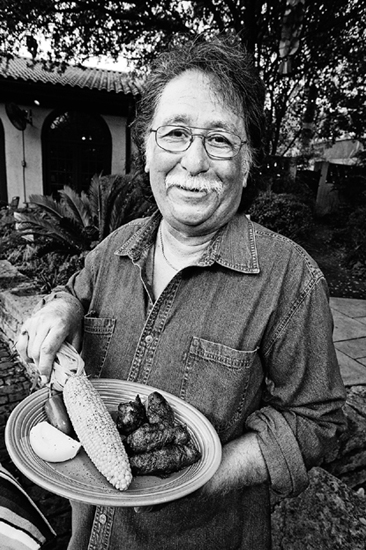
Matt Martinez Jr. demonstrating one of his favorite venison recipes
1 whole venison backstrap
3 tablespoons Tex-Mex Grill Blend
¼ cup white wine
2 cups peach preserves
2 tablespoons olive oil
5 pounds fatty pork butt
5 pounds venison shoulder, cut into pieces
2 pounds salt pork, rind removed
½ cup coarsely ground black pepper
2 cups pickle juice
10 whole cloves garlic
1 teaspoon oil for frying
VARIATIONS
For wild boar sausage, substitute wild boar or feral hog meat for the venison. For spicy hot, substitute a bottle of pickled jalapeños and their juice for the pickle juice and add ¼ cup or more of salt.
4 small jalapeño peppers
Four 1-inch chunks of cheese
4 strips bacon
MATT MARTINEZ’S BACON WRAPPING TRICK
“Stuff it with a jalapeño and wrap it with bacon” is pretty much the standard hunting-camp recipe for anything. Matt Martinez Jr. showed me a neat trick for bacon wrapping. He pounded the bacon with the side of a meat cleaver to make it thinner and more elastic. It sticks to the meat better and cooks faster, too.
Legendary barbecue man Rick Schmidt grills some dove and quail poppers on the pit at Kreuz Market in Lockhart
1 tablespoon pepper jelly or peach preserves
¼ cup white wine
12 jalapeño pepper slices or 6 peppers, halved and seeded
12 whole dove breasts or whole quail breasts
12 strips bacon
12 toothpicks
Salt and pepper
2 small jalapeño peppers
Two 1-inch chunks of cheese
6 to 8 ounces cold Venison Sausage (or substitute pork sausage or ground beef)
Cooking spray
Season the meat extra spicy and don’t overfill the bell-pepper halves when you make Grilled Stuffed Peppers
2 tablespoons seasoning blend of your choice
1 teaspoon salt (omit if there is salt in the seasoning mix)
½ cup white wine
½ pound Venison Sausage (or substitute breakfast sausage meat)
½ pound ground beef
1 cup cooked rice
2 cloves garlic, minced
1 egg, beaten
½ cup minced fresh parsley leaves
Cayenne pepper
Ground cumin
Oil, for frying
3 small green bell peppers (four lobes preferred)